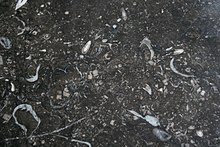Belgian granite


Belgian granite , also known as Belgian black and in the French-speaking countries Petit Granit , is the trade name of a gray-blue to anthracite-colored limestone from Belgium . The name is traditional, but misleading because it is not a granite .
Naming
There is the following explanation for his geologic wrong name:
- The name of the rock comes from the fact that this limestone contains numerous fossil fragments of sea lilies , which look confusingly similar to the feldspars stored in granites. Specifically, the name goes back to the old mining site in the Bocq Valley (east of Yvoir ), from which the rock was sold under the name Petit granit du Bocq .
The name "Petit Granit" is mentioned as early as 1806 and 1809 by Jean-Baptist Rondelet . - When the stone was imported into Germany, it was given the simplified designation of origin Belgian granite .
This rock has been proven in applications since the 15th century. Examples of this can be found in Bruges and Damme. At that time it was known as Hart steen , Escosijnse steen or goeden sausinen steenen . In the 19th century, names such as Granitelle noir de Ligny , Granit de Flandre and granitin des écaussines de Mons were also in use.
Rock description
In the black, carbonaceous, bituminous limestone, numerous parts of the stem of the fossil sea lily species Encrinus liliformis are embedded. In addition to the fossilized sea lilies, the trochites , Belgian granite contains fossil brachiopods and occasionally corals .
The stone can be worked and polished in all common ways. It is one of the few soft rocks that can be flamed. The otherwise blue-gray stone turns dark during polishing. If this natural stone is installed outdoors, it not only loses its polish in a relatively short time of two to three years, but also becomes significantly lighter or gray.
Occurrence and origin
Belgian granite is extracted in the Belgian Hainaut in the area around Soignies and Tournai in the Ourthe valley .
These rocks were formed in the early Lower Carboniferous when large masses of organic material were deposited in a sea basin. The carbonaceous, organic material did not suffer complete decomposition due to the low oxygen content of the lagoon water and the calcareous plants and animals sank to the sea floor. A black-gray limestone was created from the deposited masses by pressure. Furthermore, clay was deposited and digested sludge, bitumen, formed . During manual processing, the digested sludge is released and it creates an intense smell. This smell is no longer noticeable after processing.
From a chronostratigraphic point of view, the limestone is a deposit in the upper part of the Tournaisium , so it was formed around 350 million years ago.
use
The Belgian granite suitable for façade cladding, floor and stair coverings and bricks and is often used by sculptors. During manual processing, the digested sludge contained is released and unpleasant-smelling digester gas is produced.
Due to its similar properties, Belgian granite replaces the now exhausted bluestone from the region around Aachen and from East Belgium . Belgian granite can be confused with Irish limestone due to its similarity .
Its weather resistance is so great that it has been degraded to a significant extent. Many facades of the inner-city architecture of Brussels and other Belgian cities are characterized by this natural stone. Its high density and uniformity enable excellent polishing and various other surface treatments. His characteristic has also given him a furious variety of designs in interior design, furniture and art objects. As with all limestones, the polish is not permanent. Petit Granit has been shipped to many European countries and overseas since the second half of the 19th century . It is one of the most important European and nationally used building and decorative stones.
Competing Belgian natural stones are Noir de Denee , Noir de Tournai and Marbre Noir de Golzinne . However, they have a much smaller proportion of fossils and are predominantly deep black.
Photo gallery
Sculpture Cosmic XVII by Ottmar Mohring on the Wartberg in Heilbronn made of Belgian granite
Belgian granite tombstone (1924), Gymnich Jewish cemetery
Individual evidence
- ↑ Francis Tourneur: Marbres Wallon: Esquisse d'un repertoire. In: Robert Tollet: Dossier de la Commission royale des Monuments, Sites et Fouilles, No. 11, Liège 2004, p. 32
- ↑ A. Herbeck: The marble. Munich (Callwey) 1953, p. 67
- ↑ Alexia Lebeurre: Le Panthéon, temple de la Nation. Paris 2000, pp. 25-27
- ↑ Eric Groessens: Les pierres de construction et roches ornementales extraites dans la vallée du Bosq .
literature
- Catherine Cnudde / Jean-Jacques Harotin / Jean-Pierre Majot: Pierres et Marbres de Wallonie . Bruxelles (Archives d'Architecture Moderne) 1988
- Karlfried Fuchs: Natural stones as in the world. Discover, determine, apply. 2nd volume, p. 187, Callwey Verlag, Munich 1997
Web links
- brief characterization of the rock (PDF file; 43 kB, French)
- Stone carving with Belgian granite
- Stone sofa made of Belgian granite (PDF file; 329 kB)





